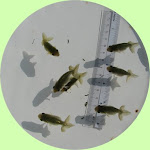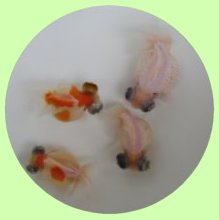Master of the Game ~ 遊戲大師
“The future was clay, to be moulded day by day, but the past was bedrock, immutable.”~ Sidney Sheldon, Master of the Game
 |
| BBR |
It's the season of the Japanese Black Baby Ranchu (BBR or kurroko 黒仔 in Japanese), named after the greenish-black colouration of the baby Ranchu that has yet to acquire its adult colouration.
Every year, from February to June is the busiest period of the year for the Japanese Ranchu breeders. It is also an exciting season for the Ranchu hobbyists as they look forward to acquire good quality baby Ranchus.
Grooming Ranchu from their baby stage may seem like trying your luck with the Japanese gachapon (capsule toy) machines ("tikum" in local Singapore context). The suspense and excitement in opening the capsule, hoping for your favourite toy model within is simply overwhelming.
However, Ranchu grooming entails more than sheer luck. The Japanese masters referred to grooming Ranchu as "making a Ranchu". They emphasized that a good Ranchu is 30% good bloodline and 70% good grooming. No doubt a higher grade BBR of good bloodline will have a much higher chance to become a good quality Ranchu, even the best Ranchu will be ruined if not groomed properly.
 |
| Gachapon goldfish |
There are techniques in making the head, body and tail of a baby Ranchu in different stages of its life. By studying the characteristics of each Ranchu, the Ranchu keeper tailor and "fine tune" their development by adjusting the food amount, food duration and food variety. They also control the amount of water change, water temperature, depth of water and the number of fishes among other things.
 |
| Ando BBR 2017 colour changed about 1.5 months after arrival |
BBRs do much better in a group than in solo or fewer fishes because by nature goldfish are sociable fishes. In a group, they are less stressed by movement and disturbances near the pond. Group grooming also promotes competition for food and mitigate the risk of over-feeding. A few fishes will take their own sweet time to finish their food because they perceived the abundance of food. On the other hand, a group of fishes will naturally compete for food and in the process, they exercise more, which aids in food digestion and the building up of a strong bone structure.
The same spawn of fish from the same breeder groomed by different keepers will turn out very differently because of varying keeping techniques and environment. There is also a saying in Japan that many of the best Ranchu keepers are those who are creative because they tend to experiment on new and different techniques in making their Ranchu.
I am thankful to a modest and avid Singaporean hobbyist (who prefers to remain anonymous) to share his grooming in this blog post:
In April 2017, he acquired 10 pieces of Ando BBR and many of his fishes turn out very well. As a typical Singaporean staying in high rise flats with the constraint of space, he successfully groomed his Ranchu indoors without the natural sunlight. The use of LED lighting indoors to mimic the natural sunlight helped in the growth of the green wall algae. In turn, the green wall algae acts as a natural filtration and also provided a nutritional food source for the Ranchu.
One of his BBR even won 6th position out of more than 50 entries in the Small Tosai class in Thailand (Mid Year Siam Ranchu Challenge 2017). The following video shows the development of the prize winning fish:
If you are game for "Ranchu gachapon",
please enquire for the annual BBR sales:
Email : juzFishArtQuatics@gmail.com
Tel: +65-96732638
please enquire for the annual BBR sales:
Email : juzFishArtQuatics@gmail.com
Tel: +65-96732638
















